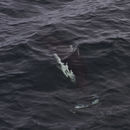Diagnostic Description
provided by FAO species catalogs
These are robust animals, with a wide-based triangular dorsal fin, and small flippers placed near the head. The small head has a short beak, with no demarcation from the melon. From above, the head appears triangular. Dall's porpoises are strikingly marked, with a black body and bright white flank patches that are continuous ventrally, although young animals have muted colour patterns. The flank patches extend from the urogenital area to just in front of the dorsal fin, and up the sides about midway. In addition, there is white to light grey "frosting" on the upper portion of the dorsal fin and the trailing edges of the flukes. There are 2 commonly occurring colour types, the dalli-type (described and illustrated above) and the truei-type (which has a larger flank patch that extends to the level of the flipper). Dall's porpoise has the smallest teeth of any cetacean. There are 23 to 28 tiny spade-shaped teeth in each tooth row. Can be confused with: Dall's porpoises are likely to be confused only with harbour porpoises, and even then, only if seen at a great distance. When seen well, the differences in colour pattern and dorsal-fin shape will be readily apparent.
- bibliographic citation
- Marine mammals of the world. Jefferson, T.A., S. Leatherwood & M.A. Webber - 1993. FAO species identification guide. Rome, FAO. 320 p. 587 figs. .
- author
- Food and Agriculture Organization of the UN
Size
provided by FAO species catalogs
Newborn Dall's porpoises are about 1 m long. Adults are up to 2.2 m (females) or 2.4 m (males). Maximum weight is about 200 kg.
- bibliographic citation
- Marine mammals of the world. Jefferson, T.A., S. Leatherwood & M.A. Webber - 1993. FAO species identification guide. Rome, FAO. 320 p. 587 figs. .
- author
- Food and Agriculture Organization of the UN
Brief Summary
provided by FAO species catalogs
This may be the fastest swimmer of all small cetaceans, at least for short bursts. When swimming rapidly, Dall's slice along the surface, producing a characteristic roostertail of spray. At other times, the animals move slowly and roll at the surface, creating little or no disturbance. These are avid bowriders, moving back and forth with jerky movements, and often coming from seemingly nowhere to appear at the bow of a fast-moving vessel. Breaching, porpoising, and other kinds of aerial behaviour, are extremely rare in this species. Dall's porpoises are found mostly in small groups of 2 to 12, although aggregations of up to several thousand have been reported. Groups appear to be fluid, often forming and breaking up for feeding and playing. Most Dall's porpoise calves are born in spring and summer. Dall's porpoises are opportunistic feeders, taking a range of surface and mid-water fish and squid, especially lanternfish and gonatid squid.
- bibliographic citation
- Marine mammals of the world. Jefferson, T.A., S. Leatherwood & M.A. Webber - 1993. FAO species identification guide. Rome, FAO. 320 p. 587 figs. .
- author
- Food and Agriculture Organization of the UN
Benefits
provided by FAO species catalogs
Conservation Status : The International Whaling Commission currently recognizes 8 stocks, based on pollutant loads, parasite faunas, and distribution patterns of cow-calf pairs. Heavy exploitation occurs in the western Pacific, both in a directed harpoon fishery and in several gillnets fisheries, in which Dall's are caught incidentally. The Asian driftnet fisheries for squid and salmon took several thousand anually in recent years in the central Pacific. Although there are records of small numbers being taken incidentally in the eastern Pacific, stocks there, unlike those in the central and western Pacific, are supposedly not in any immediate danger. IUCN: Insufficiently known.
- bibliographic citation
- Marine mammals of the world. Jefferson, T.A., S. Leatherwood & M.A. Webber - 1993. FAO species identification guide. Rome, FAO. 320 p. 587 figs. .
- author
- Food and Agriculture Organization of the UN

